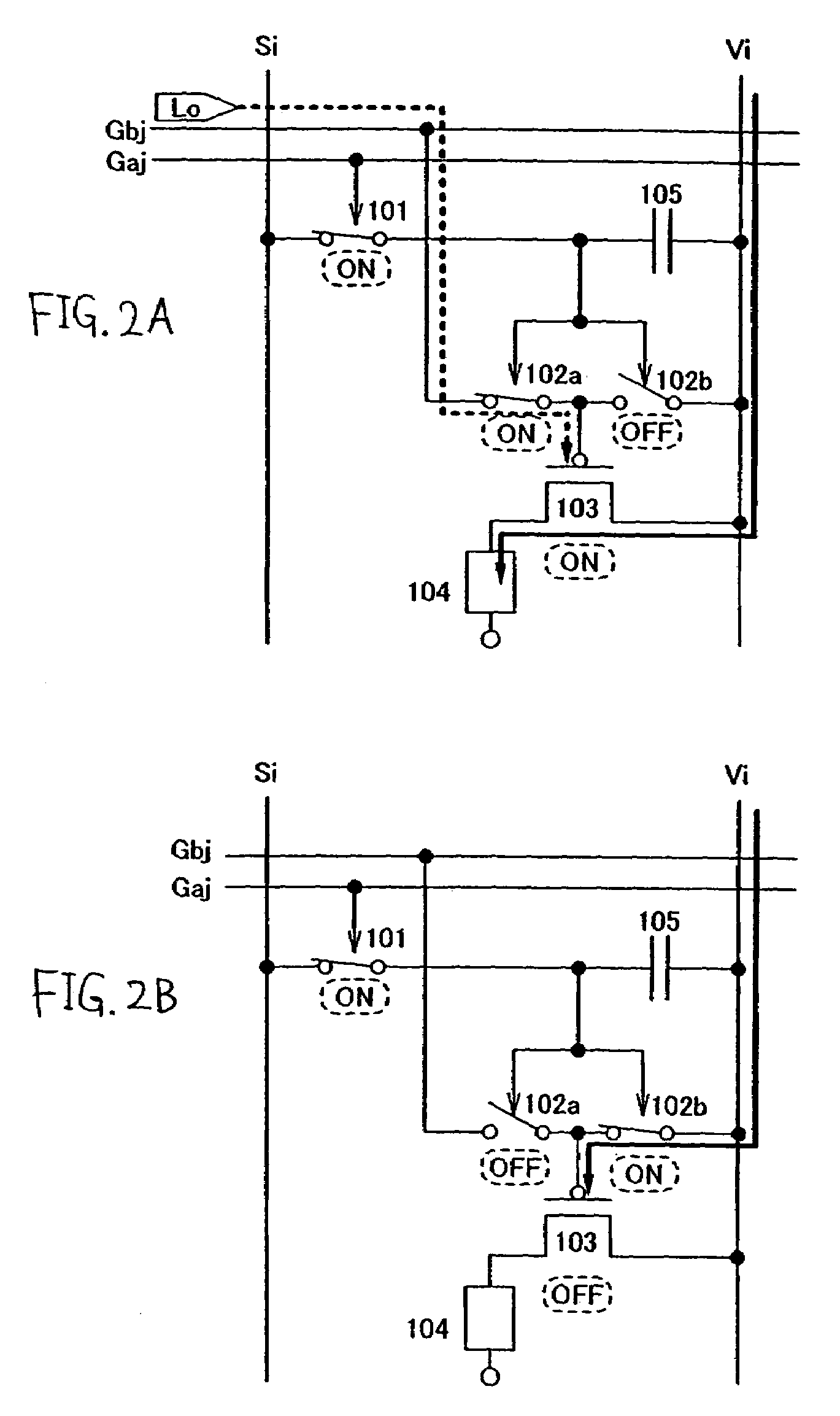Light emitting device and element substrate
a technology elements, which is applied in the field of light emitting devices, can solve the problems of difficult optimization of difficult to optimize the manufacturing process of transistors, and difficulty in observing luminance decay due to degradation of light emitting materials, so as to prevent the current supplied to the light emitting element from easily fluctuating without increasing the storage capacity of capacitors, and suppress the off-current of transistors.
- Summary
- Abstract
- Description
- Claims
- Application Information
AI Technical Summary
Benefits of technology
Problems solved by technology
Method used
Image
Examples
embodiment mode 1
[0041]Described in this embodiment mode is a pixel of the light emitting device of the invention as an example.
[0042]FIG. 1 shows a circuit diagram of a pixel of this embodiment mode. The pixel includes a switching transistor 101, a first current controlling transistor 102a, a second current controlling transistor 102b, a driving transistor 103, a light emitting element 104, and a capacitor 105. It should be noted that the capacitor 105 is not necessarily disposed in the pixel of the light emitting device according to the invention.
[0043]The gate of the switching transistor 101 is connected to a first scan line Gaj (j=1 to y), and either the source or the drain thereof is connected to a signal line Si (i=1 to x) and the other is connected to each gate of the first and second current controlling transistors 102a and 102b. The switching transistor 101 may be either an N-channel transistor or a P-channel transistor.
[0044]Either of the first current controlling transistor 102a or the se...
embodiment mode 2
[0067]Described in this embodiment mode is a pixel configuration and is operation of a pixel based on FIG. 1, in which the first current controlling transistor, the second current controlling transistor, and the driving transistor have the opposite conductivity to those in FIG. 1.
[0068]FIG. 6 shows a circuit diagram of a pixel of this embodiment mode. The pixel includes a switching transistor 601, a first current controlling transistor 602a, a second current controlling transistor 602b, a driving transistor 603, a light emitting element 604, and a capacitor 605. It should be noted that the capacitor 605 is not necessarily disposed in the pixel of the light emitting device according to the invention. The connection between each element shown in FIG. 6 is the same as in FIG. 1, however, the first current controlling transistor 602a, the second current controlling transistor 602b, and the driving transistor 603 have the opposite conductivity to those in FIG. 1. That is, the first curre...
embodiment 1
[0073]A transistor used in the invention may be a transistor formed by using amorphous silicon. In that case, a manufacturing process can be simplified as a crystallization process is dispensed with, leading to the cost reduction. The transistor formed by using amorphous silicon preferably has N-type conductivity than P-type as it has higher mobility and thus be suitably applied to a pixel of a light emitting device. Described in this embodiment is a cross-sectional structure of a pixel in which a driving transistor is an N-channel transistor.
[0074]FIG. 7A shows a cross-sectional view of a pixel including an N-channel driving transistor 6001 and a light emitting element 6002 from which light is emitted to an anode 6005 side. In FIG. 7A, a cathode 6003 of the light emitting element 6002 is electrically connected to the drain of the driving transistor 6001, and a light emitting layer 6004 and the anode 6005 are laminated in this order on the cathode 6003. The cathode 6003 may be forme...
PUM
 Login to View More
Login to View More Abstract
Description
Claims
Application Information
 Login to View More
Login to View More - R&D
- Intellectual Property
- Life Sciences
- Materials
- Tech Scout
- Unparalleled Data Quality
- Higher Quality Content
- 60% Fewer Hallucinations
Browse by: Latest US Patents, China's latest patents, Technical Efficacy Thesaurus, Application Domain, Technology Topic, Popular Technical Reports.
© 2025 PatSnap. All rights reserved.Legal|Privacy policy|Modern Slavery Act Transparency Statement|Sitemap|About US| Contact US: help@patsnap.com



